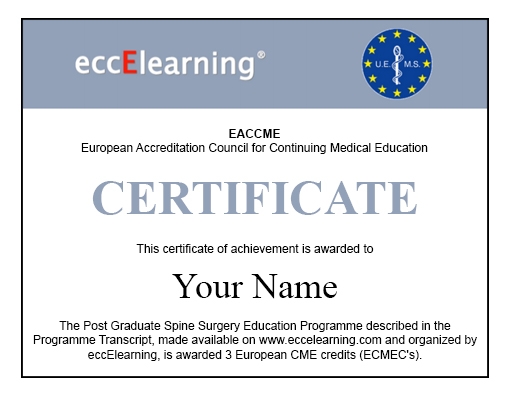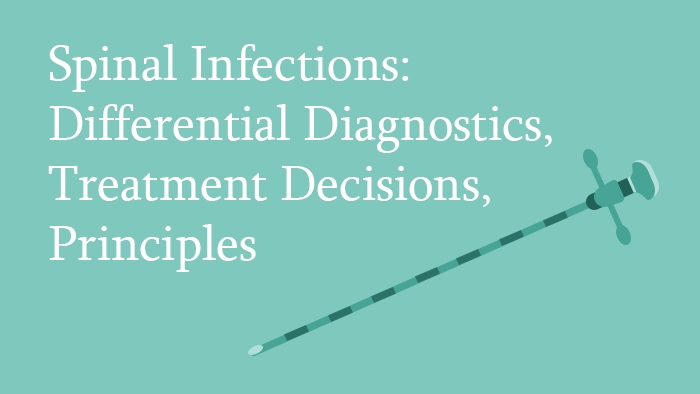Spinal Infections: Differential Diagnostics, Treatment Decisions, Principles
In this spine surgery lecture, the principles of the diagnosis and treatment of pyogenic spinal infections are presented.
Enrol to View This Lecture
Access to all 180 Spine Lectures with our Spine Surgery Education Programme.
Lecturer: Christof Birkenmaier, MD
Includes:
- Online Lecture Presentation
- Pre- and Post- Learning Assessments
- Additional Learning Materials (Standard Package only)
- Up to 3 CME Credits
DOI: 10.28962/01.3.147
Ref.ID: 8_4_birkenmaier
What you will cover in this lecture
In this spine surgery lecture, the principles of the diagnosis and treatment of pyogenic spinal infections are presented. Without a secured diagnosis, the decision for or against surgery as well as for the timing of surgery may rest on soft ground. All types of surgical approaches may be needed. Sterile cultures may point towards tuberculosis, but there are other infections that are hard to identify – suspicion is key. Quality biopsies are very valuable in our experience, even though some literature concludes to the contrary. When screening for infection (especially multifocal), PET-CT followed by MRI are most sensitive. Patients with SEA mostly benefit from rapid surgical decompression. When deciding on whether an “epidural abscess” is indeed drainable, MRI without contrast-enhanced T1-sequences may be misleading. There are currently updated, evidence-based guidelines for the institution of empiric antibiotic therapy in the presence of spondylitis / spondylodiscitis. When using implants, FU imaging / resistance to infection should be considered. It is no longer simply “titanium is best”. There are considerable developments in the implants arena – with regards to implant materials as well as with regards to infection-preventing coatings of standard metallic implants.
Learning Objectives
- To know about various types of spinal infections
- To learn the principles of diagnostic imaging
- Differential Diagnoses
- Typical and unique features of epidural abscesses
- To be able to identify patients requiring an urgent intervention
- To obtain knowledge rearding principles of selecting implants in patients with spinal infection
Target Groups
Practicing Spine Surgeons
in Orthopaedic or Neurosurgical services for Continuing Education or recertification
Lecture Presentation
Spinal Infections: Differential Diagnostics, Treatment Decisions, Principles
Includes:
- Online Lecture Presentation
- Pre- and Post- Learning Assessments
- Additional Learning Materials (Standard Package only)
- Up to 3 CME Credits

Enrol to View This Lecture
Access to all 180 Spine Lectures with our Spine Surgery Education Programme.
Frequently Asked Questions
Q: What is an eccElearning Lecture like?
A: Each Lecture includes the Lecture Presentation, Additional Learning Resources, Pre-Learning Quiz and Lecture Assessment.
Each Spine Surgery Lecture is viewed online in video format and lasts from 20-45 minutes. The Lectures contain relevant additional learning resources (book chapters, research papers, surgical videos, master lecture videos, case reports, review articles, etc.), which are presented in context and viewable immediately for your convenience.
Lecture 5.1 is an invited Master Lecture and does not include the Quiz and Assessment components.
Q: How much time will a Lecture take?
A: Lecture presentations typically take 20-45 minutes to run. However, candidates are required to review the compulsory and recommended additional learning resources contained within the Lecture. The time taken to view the Lecture and review the additional resources is in the range 3-4 hours per Lecture.
Q: What kind of credits do I get from the Lecture?
A: Each Spine Surgery Lecture can confer up to 3 Continuing Medical Education (CME) credits, certified by European Accreditation Council for Continuing Medical Education (EACCME). The CME credits are awarded to the candidate on successful completion of the online Lecture. The number awarded depend on the number of additional learning materials available in a Lecture - premium versions of the Diploma and Modules include more material for each lecture, so confer more CME Credits.
Q: What payment methods are accepted?
A: All major credit and debit cards.
Q: What are CME Credits?
A: CME stands for Continuing Medical Education. You are awarded CME Credits for undertaking an approved course of medical education. Each Lecture that you complete successfully adds to your CME Credits total. All Lectures provided by eccElearning are accredited by the European Accreditation Council for Continuing Medical Education (EACCME), of the Union Européenne des Médecins Spécialistes (UEMS). You can print out your Certificate of CME Credits after the completion of any Course or Lecture.
Q: What do I do if I fail a Lecture Assessment?
A: You are permitted to retake a Lecture Assessment up to two times. The Lecture Assessment will be made available to you again 14 days after a failed attempt. If you’ve failed the Lecture Assessment three times, please get in contact with us to discuss your options.
Q: What courses does eccElearning provide?
A: We have the Diploma in Spine Surgery with Modules individually purchasable, and Spine Surgery Specialist Certificates in Radiology and Physiotherapy.









